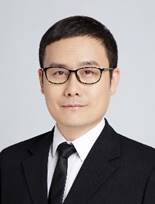Topic: Controllable Assembly and Drug Delivery Application of DNA Nanodevice
Lecturer: Ding Baoquan (Researcher at National Center for Nanoscience and Technology, Professor at University of Chinese Academy of Sciences)
Time: 19:00, November 22, 2022 (Tuesday)
Tencent Meeting: 190-268-518 (password: 123456)
Moderator: Professor Liu Huajie
About the Lecturer:

Ding Baoquan,a researcher at the National Center for Nanoscience and Technology and a professor at the University of Chinese Academy of Sciences. After graduating from the Department of Chemistry of Jilin University with a bachelor's degree in 2000 and from the Department of Chemistry at New York University in the United States with a doctor's degree in science in 2006, he engaged in postdoctoral research at the Lawrence Berkeley National Laboratory in the United States and served as a research assistant professor at Arizona State University in the United States from 2009 to 2010; he joined the National Center for Nanoscience and Technology in November 2010 and was selected into the "Hundred Talents Program" of the Chinese Academy of Sciences. He was awarded the Excellent Youth Fund of the National Natural Science Foundation of China in 2012; the National Youth Talent Support Program in 2014; the National Science Fund for Distinguished Young Scholars in 2020. He led the "Frontier Nano Technology" special project supported by the National Key Research and Development Program of China as the chief scientist in 2021. Having long been committed to the functional research of multi-principal-element self-assembled structures based on biological macromolecules such as DNA, the research led by him has developed a novel co-assembly method based on DNA nanostructures to realize the precise positioning and assembly of multiple functional elements, and elaborated the structure-activity relationship between structures and performances; has analyzed the mechanism of interaction between DNA self-assembled structures and biological interfaces, and developed a customized DNA nanodevice as an intelligent drug carrier, which offers a new strategy for the treatment of catastrophic diseases. He published more than 100 papers inNature Materials,Nature Biotechnology,Nature Communications,Journal of the American Chemical Society,Angewandte Chemie-International Edition,Advanced Materialsand other journals, as the corresponding author in recent years. The research outcomes were highlighted byScience,Nature Reviews Cancer,Nature Reviews Drug Discovery,Nature Materials,Chemical Reviewsand other magazines, and were reported by more than 100 media including Xinhua News Agency,The Timesof the United Kingdom,New Scientistand more famous media. The research outcomes reported in a paper titled A DNA Nanorobot Functions as A Cancer Therapeutic in Response to A Molecular Trigger in Vivo inNature Biotechnologyin 2018 were selected as one of the Top 10 Scientific Progresses in China in 2018, and was also selected into the 2018 Top 10 Innovations List byThe Scientistof the United States. The research outcomes reported in a paper titled A DNA Nanodevice-based Vaccine for Cancer Immunotherapy inNature Materialsin 2020 were selected among the pilot technology in the "Science and Technology Innovation China 2020" by China Association for Science and Technology.
Representative Papers:
1. S. Liu, Q. Jiang, X. Zhao, R. Zhao, Y. Wang, Y. Wang, J. Liu, Y. Shang, S. Zhao, T. Wu, Y. Zhang, G. Nie,B. Ding*, A DNA nanodevice-based vaccine for cancer immunotherapy,Nature Materials,2021, 20, 421-430
2. S. Zhao, R. Tian, J. Wu, S. Liu, Y. Wang, M. Wen, Y. Shang, Q. Liu, Y. Li, Y. Guo, Z. Wang, T. Wang, Y. Zhao, H. Zhao, H. Cao, Y. Su, J. Sun, Q. Jiang* &B. Ding*, A DNA origami-based aptamer nanoarray for potent and reversible anticoagulation in hemodialysis,Nature Communications,2021, 12, 358
3. Z. Wang, L. Song, Q. Liu, R. Tian, Y. Shang, F. Liu, S. Liu, S. Zhao, Z. Han, J. Sun, Q. Jiang* andB. Ding*, A tubular DNA nanodevice as a siRNA/chemo-drug co-delivery vehicle for combined cancer therapy,Angew. Chem. Int. Ed., 2021, 60, 2594.
4. J. Liu*, X. Lu, T. Wu, X. Wu, L. Han, andB. Ding*, Branched Antisense and siRNA Co-assembled Nanoplatform for Combined Gene Silencing and Tumor Therapy,Angew. Chem. Int. Ed., 2021, 60,1853.
5. S. Li, Q. Jiang, S. Liu, Y. Zhang, Y. Tian, C. Song, J. Wang, Y. Zou, G. Anderson, J. Han, Y. Chang, Y. Liu, C. Zhang, L. Chen, G. Zhou, G. Nie*, H. Yan*,B. Ding*, Y. Zhao*, A DNA nanorobot functions as a cancer therapeutic in response to a molecular trigger in vivo,Nature Biotechnology, 2018, 36, 258-264